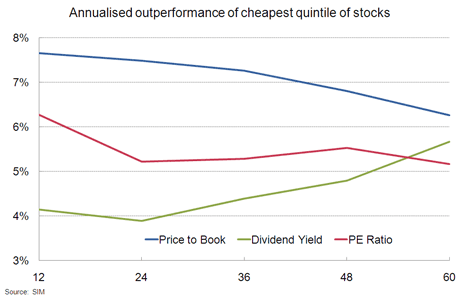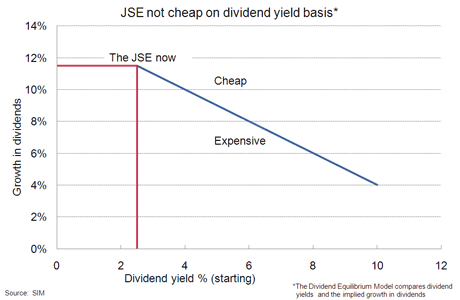When Do Dividends Matter?

Fallacy of False Cause
I was invited to participate on a panel discussion on whether dividends matter at a recent industry gathering with several of my peers from other asset management companies. I always enjoy these discussions, particularly when there’s the prospect of vigorous debate. However, there are some misconceptions about dividends that deserve further discussion:
1.Dividends are not a free lunch
When a company goes ex-dividend, the price of the stock falls by the amount of the dividend so you are effectively swapping one form of return (income) for another (capital appreciation).
2.Higher dividends (and dividend yields) do not necessarily translate into higher returns.*
(*In a study done by Aswath Damodaran, which is summarized in his book Investment Fables, low dividend yield companies actually out performed high dividend yield companies by almost 2.5% a year between 1971 and 1990. In other periods, high dividend yield outperformance was inconsistent – as with all valuation metrics that are based on accounting ratios alone.)
Logically, if a company pays out a dividend, it foregoes the potential of investing this cash in new projects that may deliver higher returns. In most instances there is a tradeoff between future growth and returning capital to shareholders. This is not true of all companies though as some companies in certain industries do not require new capital to grow. They are, however, very rare.
The black swan in the US corporate world, Berkshire Hathaway, has delivered staggering excess returns – and has never paid a dividend.
3.Dividend policy does not affect the value of a company
In their 1961 paper* , Modigliani-Miller showed that dividends are unimportant in determining the value of a company or the wealth of a shareholder.
(*M.H Miller and F. Modigliani, “Dividend Policy, Growth and the Valuation of Shares”, Journal of Business, Volume 34, October 1961
While some studies have shown that high dividend yielding companies outperform the market, these studies arguably fall prey to false cause. Dividend yield is a function of the Price to Earnings (PE) ratio of a company and its payout ratio. Mathematically, the Dividend Yield
= the Earnings Yield* the payout ratio
(*The inverse of the Price to Earnings ratio)
Therefore a high dividend yield is a function of a low PE ratio and a high payout ratio. As Modigliani-Miller have proved, the payout ratio of a company (in a world without taxes) has no impact on the value of a company, and hence the outperformance of high dividend yield companies is really a function of the outperformance achieved by buying companies with low PE ratios.
This is further evident in a study SIM did based on 14 years worth of data up to 2008. While high dividend yield companies outperform the universe of stocks, companies with low PE ratios (and Low Price to Book values) do proportionately better than High Dividend Yield companies. Rebalancing the portfolio every 12 months, companies with low Price to Book Values and Low PEs outperformed their universe by 7.75% and 6.25% respectively a year versus outperformance of just over 4% a year by low dividend yielding stocks.

Avoid heuristics
The bottom line: you should not base your assessment of a stock’s merit on the dividend alone. Dividend yield is but one factor you should consider when screening for potentially cheap companies – and it needs to be looked at in conjunction with the company’s ability to grow its dividend over time.
This involves a far more detailed assessment of several factors, which, when combined, determine the overall value of a company. For example how useful is it to buy a high dividend yielding company if the dividend over the next ten years is likely to decline in real terms.
This is best illustrated in Chart 2 below. Take company A, which trades at a 3% dividend yield, versus company B with an 8% dividend yield. The price that determines their respective yields is only representative of the fair value of each company if:
– Company A can grow its dividend at roughly 11% a year and
– Company B at 6% a year into perpetuity
Should either of these companies fall short of these growth expectations, they would both be overvalued and vice versa.
Using the same analogy, the JSE’s current low yield is implying an 11% compound annual growth rate (CAGR) in dividends into perpetuity. This compares with a 50-year CAGR of about 10%, so markets do not look cheap on this basis.
Chart 2 The Dividend Equilibrium Model – comparing dividend yield and growth in dividends.

A point in case – Anglo American dividend cut
Another great example of why it is dangerous to measure the value of a company on dividend yield alone is Anglo American. On February 20, 2009, Anglo American announced it would forego its dividend and the share price fell 16%. In fact, this proved to be the best buying opportunity for astute investors who were prepared to look beyond the contribution of one year’s dividend.
Thus to realistically assess whether a company is cheap or not, the fund manager has to understand the relationship between the starting dividend yield and the likely expected future growth in dividends over time.
This involves a detailed understanding of the industry in which the company operates; its competitive advantage (if any) and most importantly the impact of capital allocation decisions, both past and future.
Let’s take a look at the best performing dividend paying companies over the last ten years.
Dividend Aristocrats
The S&P 500® Dividend Aristocrats index measures the performance of large-cap, blue chip companies that are represented in the S&P 500 and have had a policy of increasing dividends every year for at least 25 consecutive years. This group of companies has delivered a total return of 9.2% for the past 15 years versus the S&P 500’s 6.5%. The focus here is not on dividend yield but on the consistent growth in dividend.
The list of South African companies that have consistently grown their dividends each year for the past ten years is rather short. Table 1 below highlights the 10 companies that have exhibited the most consistent growth in cash dividends over the past ten years. This select group of companies still managed to at least maintain their cash dividends during 2009. What makes for interesting reading is that 90% of these companies outperformed the All Share Index. On an equally-weighted basis, the total return delivered by these companies exceeded the total return of the FTSE/JSE All Share Index by 11% a year (refer to Table 1 below).
Table 1 Dividend Aristocrats of South Africa*
(*Computed over the past 15 years up to the of end of July 2010. We used cash ordinary dividends only and hence companies with scrip dividends are excluded.)
This highlights another important aspect of our approach to value investing, which is well summarized in the statement below:
“Growth is simply a component—usually a plus, sometimes a minus—in the value equation.”*
(*Berkshire Hathaway Annual Report, 2000)
Finally, let’s look at combining the above analyses to identify companies on attractive dividend yields where the market expectation around future growth in dividends is low compared with history and dividend growth that is likely to be sustainable.
This approach is just another tool to highlight those potential stocks that have a higher probability of delivering above-average returns in the future. It is the starting point for more detailed work.
We applied the following three criteria to identify companies whose:
1.Dividend yield today is greater than 4%, which is the after-tax yield on money market and thus encapsulates the opportunity cost of investing in one rather than the other.
2.Sustainable growth rate in dividends is above inflation, as implied by the company’s normalised Return on Equity x (1-payout ratio). The sustainable growth rate must also be above the growth rate required by the dividend equilibrium model.
3.Implied growth in dividends as reflected in the current share price is low compared to history and the average company. We use the Gordon Dividend Discount model to back out the implied growth in dividends from the current share price.
This list of companies will no doubt include some lemons. As a start I would probably avoid the companies in highly competitive industries with no sustainable advantage. Furthermore, I would stay away from any companies that have a poor history in terms of capital allocation.
Table 2 Potential Mispricing opportunities

Moral of the story
Don’t blindly fall in love with dividends as you could become love sick. Instead, use dividends as one input in a holistic approach to assessing the relative attractiveness of an investment opportunity.






Comments are closed.